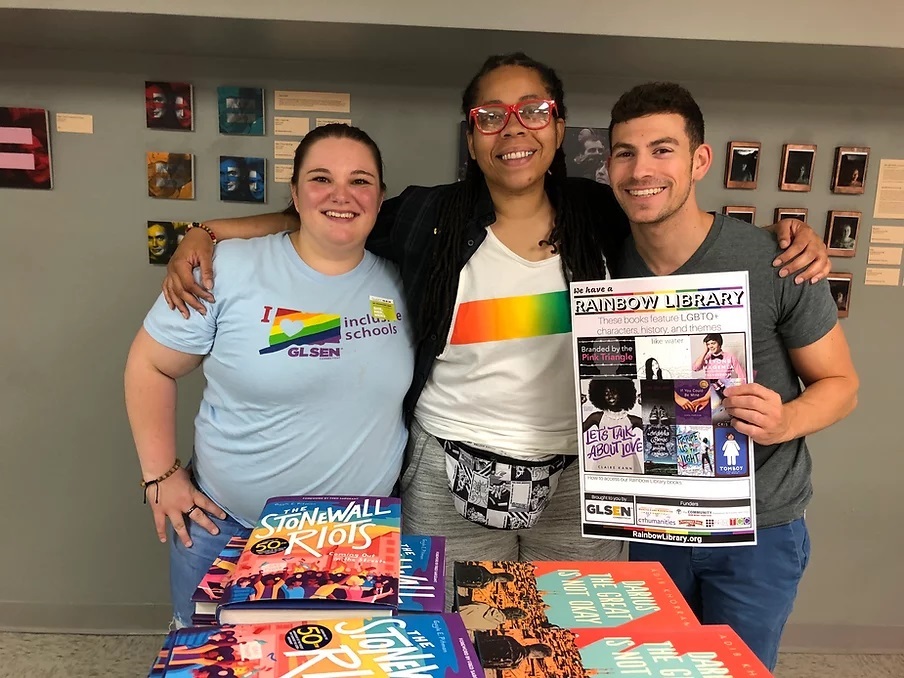Because Books Save Lives: GLSEN’s Rainbow Library stays the course on what matters
In the face of rising book challenges, Michael Rady is remarkably upbeat. Program manager of the Rainbow Library, GLSEN’s project to distribute LGBTQ+–affirming titles to schools and libraries, Rady emanates a clear-eyed sense of purpose around a program that is seeing unprecedented demand.
In the face of rising book challenges, Michael Rady is remarkably upbeat.
Program manager of the Rainbow Library, GLSEN’s project to distribute LGBTQ+–affirming titles to schools and libraries, Rady emanates a clear-eyed sense of purpose around a successful program that is seeing unprecedented demand.
Launched in 2019 by GLSEN, a national organization that advocates for LGBTQ+ inclusion in K–12 schools, the Rainbow Library has sent book sets to 1,700 locations across the United States. And interest has skyrocketed, with the program fielding 1,000 requests since September alone.
The Rainbow Library features 10-book sets geared for grades K–2, 3–5, 6–8, and 9–12. Titles are selected based on winning and nominated books for the Stonewall Award and the Rainbow Book List of the American Library Association, as well as recommendations from librarians, teachers, and students.
“We put a heavy emphasis on books that center the voices of BIPOC LGBTQ+ authors, knowing they’ve long been underrepresented among the LGBTQ+–affirming books that are in schools and libraries,” says Rady. Representation of trans authors is also a priority, and each set contains at least one bilingual book or one in Spanish.
Any full-time school staff member in a participating region may apply to receive a Rainbow set, and distributions take place twice a year, with the support of corporate and private donations.
While a growing movement to cull books from school libraries makes national headlines, with angry legislators and parents targeting titles with LGBTQ+ characters or themes, Rady has seen little pushback within his program.
Libraries as safe spaces
“What we hear way more of is the overwhelmingly positive impact of these books on communities, on kids’ lives, for families, for classroom conversations,” he says.
Beyond major cities—in rural Kansas, for example, and heavily Indigenous parts of New Mexico—program participants have reported stories of students “seeing themselves represented in a book in their school library for the first time, and being able to pick up that book and have that conversation with a teacher, friend, or family member, and how powerful this has been for a student’s own identity development, their own sense of safety, and their own excitement in learning and reading because they see themselves in the books there,” says Rady.
When a challenge does occur, he is confident that school librarians can handle it, having witnessed that firsthand. When one administrator questioned a title, Rady recalls, the school librarian knew what the rights of the kids were to access the collection. The landmark Supreme Court ruling in Island Trees v. Pico (1975) cites the First Amendment in barring a school board from pulling books from school library shelves, describing libraries as places of “voluntary inquiry.”
When the librarian communicated that, says Rady, “the administrator knew they were in the wrong and that they were putting themselves and their school in jeopardy,” so the book remained in the collection.
In addition to asserting student access to content—a right kids retain while in school—educators should know they have allies on the ground. The Missouri Association of School Librarians, for example, stood up for queer-affirming books in an early show of support of the Rainbow Library. And GLSEN has 48 chapters around the country.
Book displays are encouraged, adds Rady, and “show everyone that the school library is a place that is safe, supportive, and inclusive for LGBTQ+ people.”
 |
|
GLSEN Connecticut volunteers, with GLSEN's Michael Rady, prep Rainbow Library books for shipment. |
Resources
2019 National School Climate Survey (GLSEN):
- Only 19% of LGBTQ+ students were taught positive representations of LGBTQ+ people, history, or events in their schools while 17% had been taught negative content about LGBTQ+ topics.
- Nearly half (49%) reported they could find information about LGBTQ-related issues in their school library.
- LGBTQ+ students in schools with an inclusive curriculum reported a somewhat higher GPA than those in schools without an inclusive curriculum (3.32 vs. 3.23).
- LGBTQ+ students who attended schools with an LGBTQ-inclusive curriculum were much more likely to report that their classmates were somewhat or very accepting of LGBTQ+ people (67% vs. 38%).
- Approximately a fifth of LGBTQ+ students (20%) had access to information about LGBTQ-related topics in their textbooks or other assigned readings, just under half of LGBTQ students (49%) had access to these topics in their school library, and just over half (56%) with internet access at school had access to these topics online on school computers.
Benefits related to LGBTQ-affirming books*:
- LGBTQ students in schools with LGBTQ-inclusive curriculum, which includes LGBTQ+ affirming books:
- Heard homophobic remarks less frequently
- Heard negative remarks about gender expression less frequently
- Heard negative remarks about transgender people less frequently
- Reported less severe victimization based on sexual orientation
- Were less likely to feel unsafe at schools because of their sexual orientation and their gender expression
- Were less likely to report having missed school due to feeling unsafe or uncomfortable
*GLSEN, 2019 National School Climate Survey (pg. 60, 73-75, LGBTQ+ inclusive curriculum and affirming books)
GLSEN, Developing LGBTQ-inclusive Classroom Resources
GLSEN, Advocate for Inclusive & Affirming Curriculum
GLSEN, Libraries as Safe Spaces, Tools for Librarians


RELATED
The job outlook in 2030: Librarians will be in demand
The job outlook in 2030: Librarians will be in demand
ALREADY A SUBSCRIBER? LOG IN
We are currently offering this content for free. Sign up now to activate your personal profile, where you can save articles for future viewing





Add Comment :-
Be the first reader to comment.
Comment Policy:
Comment should not be empty !!!